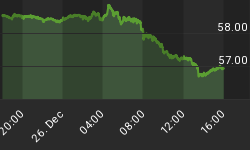Below is an excerpt from a commentary originally posted at www.speculative-investor.com on 19th June 2011.
Bank Reserves and Money Supply
The relationship between bank reserves and money supply is widely misunderstood. Some analysts believe that the Fed dictates the US money supply by controlling the reserves of the US banking system, but, as we'll explain, this is only partly correct. Other analysts believe that if commercial banks are collectively unable or unwilling to lend then the Fed won't be able to increase the economy-wide money supply, regardless of how much it increases bank reserves. As we'll explain, this view is completely wrong.
With regard to the relationship between US bank reserves and money supply, the period since 1990 can logically be split in two: September-2008 onwards and everything prior to September-2008. From the early 1990s up to and including August of 2008, changes in bank reserves had almost no influence on the money supply. We say this because there were large oscillations in the money-supply growth rate and a massive net increase in the economy-wide money supply during this period, and yet the total amount of reserves in the banking system barely moved (bank reserves were about $45B in August-1991, August 1998, and August 2008). However, from September-2008 onwards the change in bank reserves has been so important as to totally swamp all other influences on the money supply. The sudden shift in September-2008 is illustrated below.

We have a three-part explanation for what has transpired on the US monetary front since 1990. First, regulatory changes implemented by the Fed during the early-1990s effectively broke the link between bank reserves and bank lending. From then on the banks could use the practice known as "sweeping" to effectively enable any amount of bank reserves to support any amount of deposit money. Second, during the booms of the 1990s and 2000s there was huge private-sector demand for loans, which the commercial banks were willing and able to meet despite the fact that their reserves hadn't increased (due to the first part of our three-part explanation, reserves were no longer a limiting factor). The result was a large increase in the money supply driven by commercial bank lending. Third, whether it was due to the widespread impairment of bank balance sheets or a major trend change in private-sector loan demand or a combination of the two (our view is that it was a combination of the two), the banking system's collective loan book began to contract in late-2008. This would/should have resulted in deflation, except that the Fed stepped in and began creating new money at a rapid rate. Due to the way the Fed went about its money pumping, bank reserves (which are NOT counted in the money supply) and bank deposits (which ARE counted in the money supply) were simultaneously boosted.
In summary, almost all the money created in the US from the early-1990s through to August of 2008 was created by the private banks, independently of changes in bank reserves. This, we suspect, is why some analysts concluded that the US would necessarily experience deflation once the private banks became unwilling to expand their loan books or private-sector borrowers became 'tapped out'. However, the world changed in September of 2008. From that time forward, the Fed has been solely responsible for net additions to the US money supply.
A secular trend change in the credit market
We disagree with the main conclusion of the analysts who are forecasting deflation for the US economy, but our assessment of the inflation/deflation situation also differs from that of most analysts who are forecasting more inflation.
As far as we can tell, most analysts who are convinced that a lot more inflation lies in store for the US economy believe that it's just a matter of time before the long-term upward trends in commercial bank lending and private sector indebtedness resume. Our view, however, is that the aforementioned long-term trends ended in 2008 and that future inflation will rely on the Fed's creation of new money.
Growth in the federal government's debt burden will probably ensure that the economy-wide volume of debt continues to increase, but in any case the Fed has proven beyond any doubt that it is capable of expanding the supply of money at a fast pace regardless of what is happening on the debt front. The fact is that while almost all new money is borrowed into existence during normal times (normal, that is, for the type of monetary system we have today), the Fed is able to create new money independently of demand for loans. It can do this because it is capable of monetising ANYTHING.
Evidence of a change in the US credit market's long-term trend is provided by the following chart of revolving credit. The post-2008 downturn does not look like an interruption to a long-term upward trend; it looks like the start of a new long-term downward trend.

We aren't offering a free trial subscription at this time, but free samples of our work (excerpts from our regular commentaries) can be viewed at: http://www.speculative-investor.com/new/freesamples.html
















